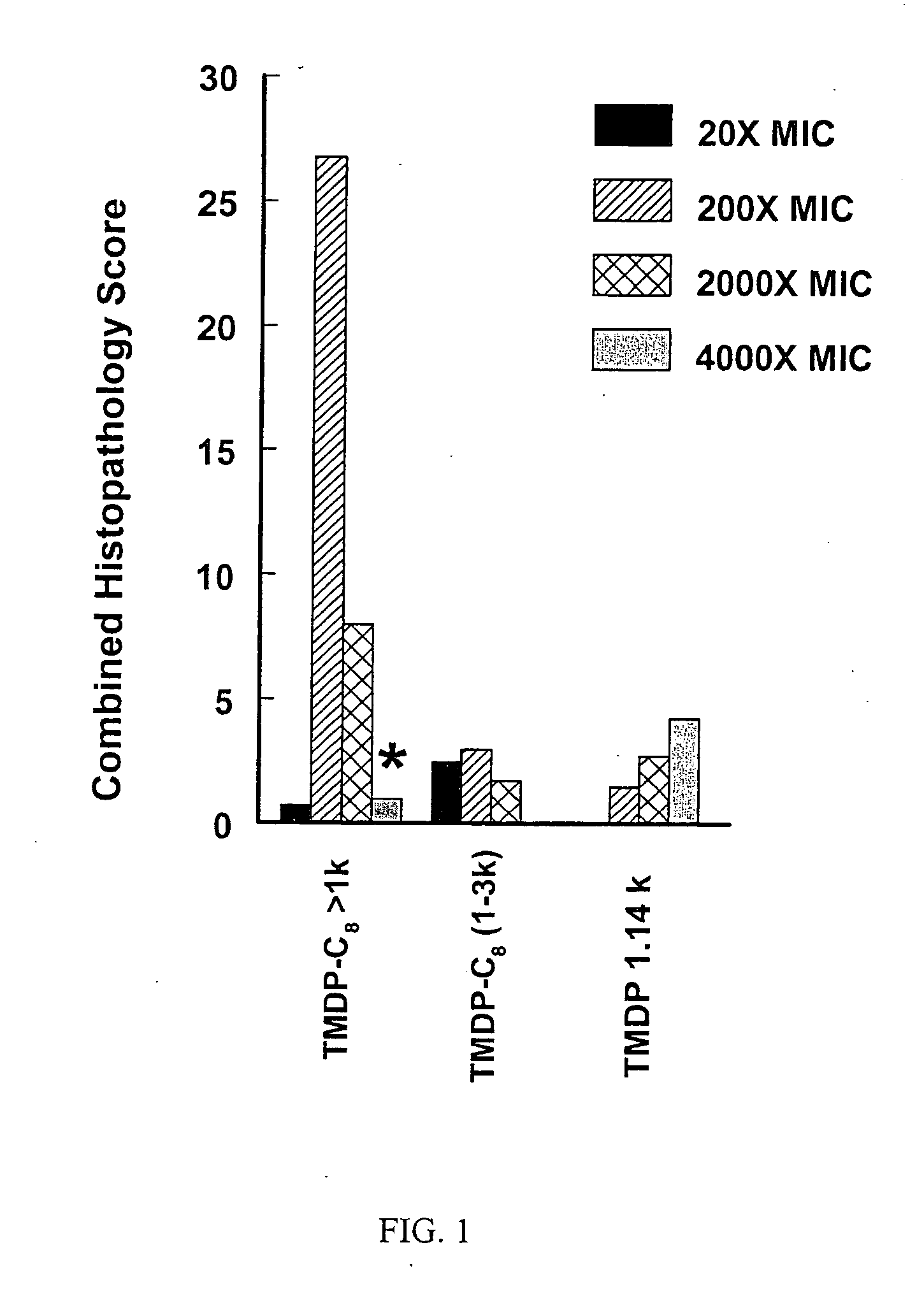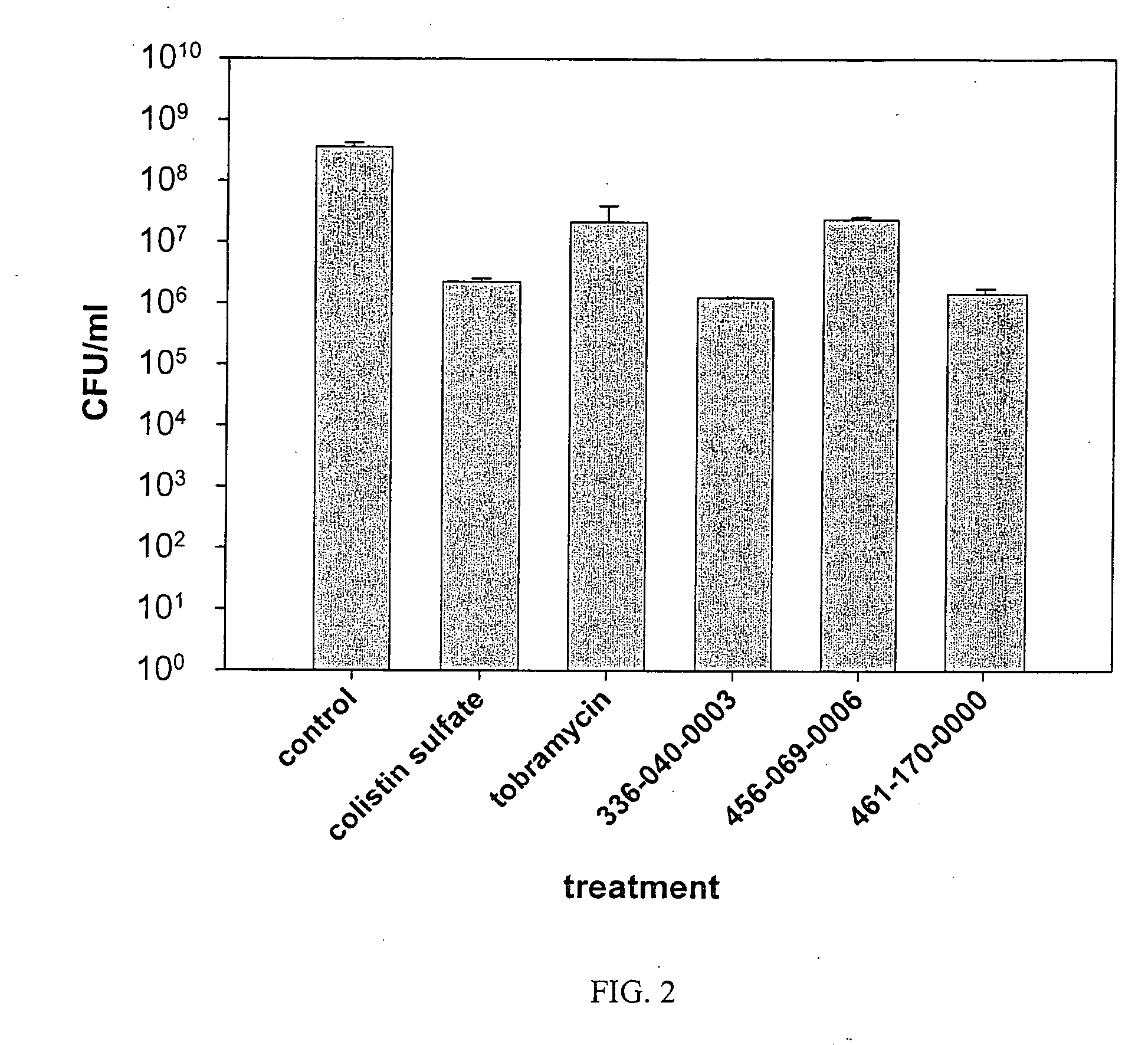Ionene oligomers and polymers
a technology of applied in the field ofionene oligomers and polymers, can solve the problems of ineffectiveness of many important therapeutics for the treatment of infections, inability to remove, and biofouling of the surface, and achieve the effect of reducing toxicity
- Summary
- Abstract
- Description
- Claims
- Application Information
AI Technical Summary
Benefits of technology
Problems solved by technology
Method used
Image
Examples
example 1
Preparation of Poly(trimethylene dipyridine-alt-2,7-dihydroxyoctane)
[0127] 4,4′-trimethylenedipyridine (100 g) was transferred to the lower portion of a 1 L reaction flask. Neat liquid diepoxyoctane (71.72 g) was added to the reaction flask. The reactor contents were stirred under nitrogen at room temperature for ten minutes or until most of the 4,4′-trimethylenedipyridine has dissolved. Stirring neat acetic acid (121 g) was added dropwise through the constant addition funnel over a 24 hour period at room temperature under nitrogen. The reaction became dark blue and very viscous. The reaction mixture was stirred at room temperature for an additional 4 days. The reaction mixture was dissolved in deionized water (1 L). The pH was adjusted to about 0.8. The solution was heated to 50° C. and stirred at that temperature for 48 hours. The reaction mixture was allowed to cool, diluted with deionized water to 16 L, and then neutralized with NaHCO3. The mixture was purified through a tangen...
example 2
Preparation of Poly(trimethylene dipyridine-alt-2,7-dihydroxyoctane)
[0128] In a 1 L, 3-neck round bottom flask under N2 with a temperature probe and 60 mL pressure equalizing funnel, 20.539 g (0.104 mol) of 4,4′-trimethylenedipyridine and 13.6 mL (0.093 mol) of 1,2,7,8-diepoxyoctane was added. The reaction was stirred for 1 hour under N2. The dipyridine was not completely dissolved. Acetic acid (75 mL) was added over 0.5 hours through the pressure equalizing funnel. With addition of the acetic acid, the reaction temperature began to rise (reaching 42° C.), so the reaction was put in an ice bath to maintain the temperature below 30° C.
[0129] After 24 hours of stirring under N2, an aliquot was removed for reverse phase HPLC. The HPLC indicated that the reaction had proceeded, therefore the flask was put in an ice bath and ion exchange was performed by adding 300 mL deionized H2O and 300 mL of 37% HCl (3.65 mol, 2.8 times the CH3COOH). The reaction was then heated to 50° C. After app...
example 3
Procedure for Synthesizing an Array of 72 Polyionenes Using Dimorpholinos or Dipiperidines and Dibromides
[0131] Stock solutions (3.2M) of six different dimorpholinos and dipiperidines and 12 different dibromides, all of which are shown below, were prepared in DMF. One-half ml of each sample was added to 8 ml tared and labeled vials, which were set up in an 8×12 array. Materials that would not dissolve in DMF were added neat to their appropriate vials (1.6 mmol) and 200 microliters of DMF was added as well. The samples were placed on a heater / shaker block at a temperature of 50° C. and shaken for 7 days. After four days, the temperature was turned up to 65° C. 200 microliters of deionized water was added to each sample after five days. After 7 days of heating and shaking, the samples were cooled to room temperature and precipitated with ether. Approximately 3 ml of ether were added to each sample. The sample was vortexed and allowed to settle. The ether was decanted off. This precip...
PUM
| Property | Measurement | Unit |
|---|---|---|
| molecular weight | aaaaa | aaaaa |
| molecular weight | aaaaa | aaaaa |
| molecular weight | aaaaa | aaaaa |
Abstract
Description
Claims
Application Information
 Login to View More
Login to View More - R&D
- Intellectual Property
- Life Sciences
- Materials
- Tech Scout
- Unparalleled Data Quality
- Higher Quality Content
- 60% Fewer Hallucinations
Browse by: Latest US Patents, China's latest patents, Technical Efficacy Thesaurus, Application Domain, Technology Topic, Popular Technical Reports.
© 2025 PatSnap. All rights reserved.Legal|Privacy policy|Modern Slavery Act Transparency Statement|Sitemap|About US| Contact US: help@patsnap.com



